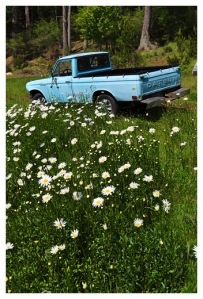A full moon crests Cypress Island and casts across the gentle sea an orange beam of light, which progressively reaches further and further until it creeps across the bedroom deck, enters the sliding door and floods my toes, my legs and my eyes with light. “Get up” it beckons. “Look at me!”
I force open my eyes and – now propping my head on one elbow — stare out across the sea lit magnificently by the beam. I may be half asleep, but “I’m up. I’m up.”
In moments like this, I fight the urge to scurry out of bed and grab a camera. But I’ve learned it’s better for me to observe than capture. Besides the fact I am utterly helpless with even an automatic camera, look-at-me moments happen frequently here and quickly – very quickly. By the time I’ve grabbed the camera, (or found the camera,) adjusted a setting and flung myself to the nearest vantage point, the moon usually slips behind a cloud, an eagle passes, the seal dives, the rainbow softens.
While moments transition quickly here, I am certain of one thing: another look-at-me moment is just around the corner. If not tonight, then tomorrow, perhaps Tuesday — and often when I least expect it.
But the problem with these look-at-me moments is I’m constantly interrupted. It’s difficult to work, eat, sleep or watch a movie when an ooh-ahh something is transpiring. Nature, I’ve found, is very self-centered.
Recently, for example, S and I were barely 30 minutes into the movie “Bright Star,” a period piece, which certainly requires attention and deserves respect – it’s about Keats for goodness sakes – when it begins to rain. This of course produces a rainbow, which I happened to catch out of the corner of my eye. Without pausing the movie, I get up and walk to an adjacent window for a better view. (It’s worth the walk.) By the time I return to the movie, I notice the rainbow now forms a perfect arc spanning four miles toe-to-toe — from Lummi to Cypress — with both brightly-colored feet dipping into the sea. (See the rainbow.)
So, now I have to pause the movie, find the camera, adjust some settings, take a half-dozen photos, which do not in the least capture its magnitude. All the while cute little tugs and barges and seals fill the horizon, the sun dapples light on South Peapod and gulls with bright white underbellies fill the sky. Is it my imagination or did I hear a director say, “Cue the porpoises”?
In the end the two-hour movie takes us three hours to watch. See what I mean?
If it’s not a full moon or rainbow distracting me, then it’s the remnants of a sunset, the clouds gathering to storm or peaks of the North Cascades, which now pester me as I try to write. “Can you see our snow caps?” they ask. Showoffs! It’s hardly fair. How can I concentrate?
Last week I’d barely finished making dinner — a delicious spread of chicken tacos, refried beans with fresh cilantro — when two orca whales surfaced not 40 feet from our shoreline. Thirty minutes earlier we’d watched them pass east of the Peapods, flanked with gawking boaters. We assumed they were heading south until we noticed the boaters — who by the way were illegally following the whales — had repositioned their boats west of the Peapods.So, we oohed and aahed — until my arm grew stiff from holding the binoculars — then we retired to the kitchen, plated dinner and were about to settle in to the meal when we heard the spout of air and seawater emanating from the whale blowholes. I rushed off to the lower deck while S scurried down the hillside to the water’s edge, camera in tow.
By the time they’d passed and S returned, our tacos were stone cold. We spent the rest of the evening looking at the photos from the back of her camera. Who wanted tacos anyway?
I’M STANDING IN THE LIVING ROOM FACING THE PICTURE WINDOW when I see him heading straight toward me. “Look. Look,” I say, pointing quickly to the window, giving S just enough time to turn her head.
The bald eagle glides effortlessly toward us. We can see his eyes; he can see ours. Twenty feet from the window he turns left, flaps his wings twice and disappears beyond the trees. It’s like watching an IMAX movie in our own living room.
“Alright, that’s it,” S says. “We’ll just have to keep a camera strapped to our heads.”
She may be right. How else can we capture big?
© 2010 Susan Anderson and “Away here.” Unauthorized use and/or duplication of this material without express and written permission from the author is strictly prohibited. Photos © Orcas Island Photos.





